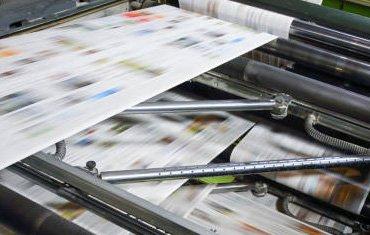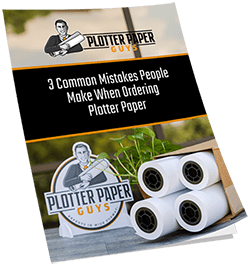Plotter paper size guidelines internationally have been in dispute for hundreds of years. Different countries have different rules about the standard sizes of plotter paper, going all the way back to how paper was originally taxed.
Many of the countries decided that the paper should be sized based on the Golden Ratio, a famous mathematical formula. But you don’t need to math to find out which plotter paper size is the best for your business! We have everything you need to know about large format paper sizing here in this guide, so read on!
How to Read Plotter Paper Size Specifications
When you order plotter paper, you may sometimes see the size of the paper written out with a string of numbers referring to the weight, width, length, and core diameter, in that order. You need to make sure you have all of these sizes correct, or there’s a chance your paper won’t fit in your inkjet plotter.
Paper Weight
The first number is the weight of the paper in pounds. This is the weight of 500 standard-sized sheets of this paper, which refers to the paper’s thickness. Standard printer paper is usually 20#, or 20 lbs.
Another way to discuss paper weight is the caliper. Caliper is measured in increments of 1/1000 of an inch, which are called “mils.” Older machines that use bond paper require you to print on 9 mil paper or less, but newer inkjet printers can usually print on paper that is much thicker than that.
Paper Width
The second number in the specification tells you how wide the paper is.
This is crucial to know, since paper that is too wide for your plotter
will not fit. Standard sizes vary by industry, so we’ll come back to that
in a moment.
Length of Rolled Paper
The length of the bond paper is the third number in the list, and refers to the total length of that roll of paper. Many standard-sized rolls in the US come in 150, 300, or 500-foot rolls. Having longer paper lets you print more before changing the paper, and it can affect the length of documents you can print.
Roll Core Diameter
The core diameter is the last number in the list, and it’s important to check that your printer can fit a roll of this size before you order. Inkjet printers usually use 2″ diameter cores, but toner printers use 3″ cores.
Standard Plotter Paper Sizes in the United States
Here are the standard letter sizes that are used in the United States. These are measured in inches, and it refers to the width by the length of the paper as it is usually sold in sheets.
A = 8.5 x 11 inches, and is the standard size for regular printers
B = 11 x 17 inch paper
C = 17 x 22 inch paper
D = 22 x 34 inch paper
E = 34 x 44 inch paper
F = 28 x 40 inch paper
Since these are measured in sheets, you should probably decide which plotter paper size to get based on the width of the paper you will need. So if you are printing a large amount of 11 x 17 or size “B” documents, you can get your plotter paper rolls in 11-inch widths, and print them out to 17 inches at a time.
Plotter Paper Size for Architecture
If you need to print architectural drafts, the size of paper you will need
is different from the standard US letter sizes. These sizes are also
lettered but have “ARCH” in front.
ARCH A = 9 x 12 inch paper
ARCH B = 12 x 18 inch paper
ARCH C = 18 x 14 inch paper
ARCH D = 24 x 36 inch paper
ARCH E = 36 x 48 inch paper
These are the standard sizes for architectural drawings, so if that is
what you most commonly need to print, you’ll want to get your paper in
widths of 9, 12, 18, 24, or 36 inches.
Plotter Paper Size for Engineering
If you are printing blueprints for engineering, they have their own standard sizes for engineering drawings that are different from the architectural sizes. These are labeled with ANSI before the letters, which stands for the American National Standards Institute.
ANSI A = 8.5 x 11 inches
ANSI B = 11 x 17 inch paper
ANSI C = 17 x 22 inch paper
ANSI D = 22 x 34 inch paper
ANSI E = 34 x 44 inch paper
Luckily, these sizes are the same as the standard US sizes, but the
letters are different. So, for engineering drawings and for standard US
needs, you’ll mostly order in widths of 11, 17, 22, 34, or 36 inches.
You should also note that the weight or thickness of blueprint or draft
paper is usually much thinner than standard paper, since it needs to roll
up or layer well over other sheets of paper.
ISO Plotter Paper Sizes
Finally, let’s look at the standard sizes of plotter paper that are used internationally. ISO stands for the International Standards Organization, which makes the rule on the standard paper sizes used all over the world outside the United States. Since the US is one of the only countries that uses imperial units instead of the metric system, standard paper sizes internationally are in units of millimeters. Not to worry, we have that converted to inches for you to save you the headache.
These plotter paper sizes are labeled with the letter A followed by a number.
A0 = 841 x 1189 millimeters, or 33.11 x 46.81 inches
A1 = 594 x 841 millimeters, or 29.23 x 33.11 inches
A2 = 420 x 495 millimeters, or 16.54 x 22.23 inches
A3 = 297 x 420 millimeters, or 11.69 x 16.54 inches
A4 = 210 x 297 millimeters, or 8.27 by 11.69 inches
These are the standard drawing sizes used by almost everywhere outside the US, so if by chance your inkjet plotter comes from another country, there’s a good chance you may need one of these sizes of paper rolls instead of the standard American sizes.
Finding the Right Plotter Paper Size for You
We hope this guide helped you find the right size paper for your printer! Keep in mind the weight or thickness of the paper when you order, depending on if you want standard bond paper or thinner draft paper. If you need help, we also offer custom sizing to fit your needs.
Let us know if there’s anything we can do to help you find the perfect plotter paper size!




